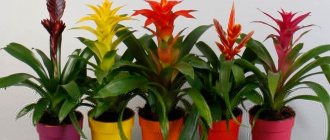Author: Tamara Altova. September 24, 2017
Category: Houseplants.
Amaryllis (lat. Amaryllis) is a genus of monocotyledonous plants of the Amaryllidaceae family, until 1998 it was considered monotypic, but now this genus, according to The Plant List, includes four species. Some of the amaryllis that were previously included in this genus have been transferred to the genus Hippeastrum. In nature, amaryllis are found in semi-deserts and deserts of Africa, Asia and America, as well as in the American prairies. Only amaryllis belladonna, native to South Africa, is grown indoors. The specific name of the plant - Belladonna - was given in honor of the beautiful shepherdess, sung by the great Virgil. The name is quite justified: amaryllis is not only an ornamental deciduous plant, but also a beautifully flowering plant.
History and geography
Amaryllis was brought by botanists and travelers to Europe from South Africa. Its first settlement took place in the botanical gardens of famous persons. The mention of this marvelous flower dates back to 1753. It was discovered in the mayor's garden of Amsterdam, the oldest botanical garden in the world.
He came to the windowsills much later. In the USSR, the peak of its popularity occurred in the 60s of the last century, when people, tired of war, hunger and devastation, began to decorate their homes with strange plants. It was then that amaryllis came to everyone’s rescue, shining with rare beauty and flexible character.
Amaryllis and hippeastrum - similarities and differences
Many people wonder how amaryllis differs from the hippeastrum flower. They are often confused with each other. Let's try to figure it out using a comparison table.
| Amaryllis | Hippeastrum | |
| Homeland of origin | South Africa | South, Central America |
| Plant classification | Bulbous | Bulbous |
| Genus | Amaryllaceae | Amaryllaceae |
| Bulb size | 5-10 cm | 5-10 cm |
| Bulb shape | Pear-shaped | Conical with neck |
| Number of peduncles | 1-2 | 2-5 |
| Description of leaves | Long, green, tongue-shaped | Long, tongue-shaped, the color is all shades of green, sometimes purple. |
| Leaf parameters | Length from 0.3 to 0.5 meters Width 3 cm | Length 0.6 to 0.7 meters, width 4-5 cm. |
| Presence of leaves during flowering | Leaves die before flowering | Leaves don't die |
| Peduncle height | 30-60 cm | 35-80 cm |
| Number of colors | 2-12 | 2-6 |
| Flower diameter | 6-10 cm | 12 or more cm. |
| Presence of aroma | Pleasant aroma | The aroma depends on the varieties |
| Number of petals | 6 | 6 |
| Description of the peduncle | Fleshy | Hollow |
| Flower shape | Funnel-shaped | Funnel-shaped |
| Color | Varied color palette | Varied color palette |
| Flowering time at home | Most often in autumn | Late winter to mid spring |
| Number of representatives in the clan | Sole representative | About 90 species |
| Growing in open ground | Allowed | Forbidden |
Popular varieties of amaryllis
The genus includes a single species, known under two names - Amaryllis Beautiful and Amaryllis Belladonna. The perennial plant has a bulbous root system and sword-shaped leaves arranged in two rows. The peduncle is tall, can reach 60-80 cm in height. When flowering, an inflorescence is formed on each branch, consisting of 6-12 flowers, reaching 6-10 cm in diameter.
Attention! Flower growers liked amaryllis so much that work on developing new varieties has been going on for several decades. Hybrids are popular due to their ease of maintenance. They bloom readily and are rarely attacked by pests.
@ Dewins stock.adobe.com Characteristic structure of a flower
The list of popular varieties includes:
- This variety is valued for its huge flowers; they reach 10 cm in diameter and are colored in a rich carmine-burgundy shade.
- Pink-flowered variety. The stipules are colored yellow at the base. The flowers themselves are medium in size, reaching 6-8 cm in diameter.
- Ice Queen. A large-flowered variety with rich white petals with a slight cream tint along the edges.
- A popular variety of amaryllis that blooms with pink flowers. Its distinctive feature is that the petals have a light pearlescent coating, which gives the plant gloss and makes it more attractive.
- Red Lion. The most popular variety with red flowers reaching 10 cm in diameter. Valued for its ease of maintenance and ability to bloom up to 5 times per season.
- La Paz. A new product of foreign selection. It is distinguished by narrowed petals, painted in a light greenish color. They have a red-crimson edging.
Please note that the presented list only considers popular and common varieties. They can be purchased at a specialty store. Other, rarer varieties should be sought from people professionally involved in growing amaryllis plants, including breeders.
Watering mode
Excess moisture can cause the bulb to rot. The next watering is carried out after the soil in the flowerpot has completely dried. The time and amount of watering depend on the condition of the plant. During the dormant period, it is not watered at all, but during the period of awakening and flowering, more humid growing conditions are created. Water is poured into the pan; contact with the water bulb is not desirable. Water for irrigation should be at room temperature and filtered.
Ideal: melt, rain, spring water. Chlorinated tap water is harmful to the exotic Amaryllis flower
Optimal conditions for growing a flower
Suitable conditions for growing amaryllis at home differ markedly depending on whether the plant is in an active growth phase or has entered a dormant period.
Suitable conditions for the plant depending on the phase of development - table
| Conditions | Growth phase | Rest period |
| Pot location | Window facing southwest or southeast. A south window will also work, but you will have to cover the plant from direct sunlight during the day so that the leaves do not turn pale or fade. | A dark and cool place with a constant temperature and good ventilation. |
| Lighting | Ideally, bright but diffused light is needed for 14–16 hours a day. The leaves and especially the peduncle tend to reach towards the sun, so periodically they will have to be returned to a vertical position by turning the pot. Or you can make supports for the plant. | Not required. |
| Humidity | The plant is moisture-loving. For irrigation, use room temperature water that has stood for 6–8 hours. The soil should not dry out, but you should not over-water the flower either. It requires more water only during the flowering period. Stagnation of moisture leads to the leaves withering and losing color, and the roots rotting. Spraying the leaves has virtually no effect on the flower. But before flowering, you can slightly moisten the buds. Maintain air humidity at 60–80%. | Watering is completely eliminated. Only soil spraying is carried out. Watering begins again only when the new peduncle grows to 10–12 cm. The optimal humidity in the storage area is 60–70%, without sudden changes. |
| Ventilation | The room should be well ventilated, but avoid strong drafts. | |
| Temperature | Approximately 22–24ºС during the day and about 18ºС at night. The plant does not like sudden temperature changes. | Constant temperature 10–12ºС. |
Top dressing
It is necessary to feed Amaryllis. These activities are carried out at the end of the dormant period to activate growth and flowering. It is customary to alternate organic and mineral fertilizing, once every 2-3 weeks. Choose mineral fertilizers for decorative flowering bulbs, consumption 3g/1 liter.
We also recommend: Eustoma planting and care at home
It is important to comply with fertilizer consumption standards. When applying liquid fertilizers, it is important not to get the mixture on the bulb itself, in order to avoid burning it.
Grandma's advice! You can use mullein as an organic fertilizer. The main thing is to maintain the ratio of 250g/10 liters. This way you can feed all your house plants at once.
Growing from bulbs
Before planting, you need to check the bulb for density, absence of damage, mold, rot and the presence of developed roots. If affected areas were found during the inspection, they must be cut off and the problem areas treated with charcoal.
It is also necessary to remove dead scales and disinfect the bulb in this order:
- Soak in the potassium permanganate solution for half an hour.
- Treat with fungicides.
After 24 hours, the planting material will dry out, and then it can be planted in open ground.
Worth knowing! When purchasing material, it is important not to confuse it with hippeastrum bulbs. The latter is not able to grow and develop in “street” conditions
The hippeastrum bulb is round in shape, larger in size, and its surface is covered with light-colored scales.
Amaryllis must be planted outdoors according to the following rules:
- Planting is carried out in late spring - early summer.
- Drainage is placed at the bottom of the hole.
- The bulbs are completely buried in the substrate (15 cm) and placed at a distance of 25-30 cm from each other.
- Immediately after planting, mulch is done so that the surface of the earth does not dry out.
The beds should be watered moderately until the height of the shoots reaches 10 cm, and then switch to abundant watering. If you neglect this rule, the amaryllis may not bloom: all the energy will be spent on forming a lush rosette.
On a note! During the period of active growth, peduncles can reach such a height that they begin to bend under the weight of their own buds. To prevent the flower from breaking, it is recommended to install a support.
The soil must be fertile and loose to allow air and moisture to pass through well. If the soil does not meet the specified requirements, organic and mineral fertilizers are added to it, and drainage is also carried out. Shoots appear in late summer - early autumn. Flowering begins at 2-3 years.
Propagation by bulbs
Planting and transplanting
Flower transplantation is carried out for various reasons and should not be neglected. Amaryllis can be replanted annually and it will not cause harm, or less than once every 2-3 years. The less frequent the transplant, the more “babies” can be born on the mother’s bulb. Reason for transplant:
- Dying of old soil;
- Unsuitable flowerpot (too big or too small);
- For reproduction;
- When “kids” appear.
Transfer rules
In order to correctly transplant amaryllis, you need to know the basics of floriculture.
- The time for planting (transplanting) amaryllis is in July (the awakening period) or after the end of flowering, when the peduncle dries out. During the dormant period, the flower is not replanted. After transplantation, the new root system of amaryllis grows in 1.5-2 months and it will be ready for new feats of flowering.
- The flower pot for planting is of great importance. You need to measure the diameter of the bulb. For planting, you will need a pot - the diameter of the bulb plus 6 cm.
- When planting, the bulb deepens by ½ part. This is a must.
- If you plant a young onion, it is important to preserve the leaves, they help the onion to feed and mature.
- Place drainage (expanded clay) and a handful of sand at the bottom of the flowerpot so that water does not stagnate in the ground.
- As the bulb increases in size, soil is added to the pot.
- Each pot grows 1 onion.
Which soil to choose
African amaryllis needs loose and oxygen-containing soil. A ready-made mixture “for bulbous flowers”, which is sold in flower shops, is universally suitable. The soil environment is neutral, not acidified. If you wish, it is not difficult to do it yourself.
Soil recipe for Amaryllis: humus (compost), river sand, leaf soil, turf soil and peat (in equal parts). Before use, the soil is sterilized in the oven or over an open fire.
Which pot to choose
A heavy clay pot is suitable for amaryllis. The plant is light and may well fall from the windowsill during a draft. In addition, clay is a breathable, natural material, more useful than budget plastic.
In the southern regions, Amaryllis can be planted in a garden plot in the summer. There he will have a great time until autumn, gain strength and strengthen his immunity. Of course, you will need to make sure that his exotic majesty is not destroyed by garden pests
Problems with growing amaryllis
Like all plants, amaryllis also has problems. Don’t be upset, almost all of them can be solved, be more attentive to your green pet. These are the problems:
- The amaryllis flowers began to darken and even turn black, what happened to it? And the reason is you, don’t monitor the temperature, the flower has become cold, it is a child of Africa. Arrange it in a warm, bright place, you will again admire these luxurious flowers.
- The inflorescences have become pale, direct sunlight is to blame for this reason, you were warned, this flower requires a lot of light, but it does not tolerate direct sunlight.
Amaryllis stopped blooming, there are several reasons:
- you did not put it in a cool place, which means you deprived the plant of a dormant period;
- fed poorly or not at all;
- the flower was in a slight shade, maybe a large neighbor was blocking its light, again your fault, you didn’t look after your pet;
We bought a blooming amaryllis, the flowers bloomed amazingly, but the next year it refused to bloom. Why? Let's figure it out, did you constantly feed it during the growing season, from time to time, or not at all? Well, what did you want, the hungry don’t have fun, excuse me, they don’t bloom. The plant, especially with such large flowers, requires constant feeding once every 2 weeks. Please remember.
Solve the problem! It's time to deal with leaf problems
The leaves turned pale, drooped, the flowers hung their heads, what happened to them? And again your inattention, the earthen lump is absolutely dry. The soil of this plant should be moist, understand, not damp or dry, but moist and watering should be done through a tray
Please clarify.
Limp and pale leaves, same reason. Watering standards are not followed, It’s too damp, If it’s difficult for you to guess the amount of liquid for the plant, there is an elementary way out: give it drip watering. The plant will take the amount of water it needs.
A well-developing plant pleased you with its appearance, and at one fine moment it suddenly stopped growing, what was the reason? There are probably pests in the bulb, look if there are larvae in the soil, it’s better to spill the soil with an insecticide. It won’t get worse; prevention has never harmed anyone.
You know, this is the most common reason. You bought an adult bulb at a flower shop. They put it in a pot, it doesn’t grow, what’s wrong? When you planted it, did you take a good look at it? It had to be solid and have no external flaws. Give it a period of 1.5 months, the sprout has not hatched, you can safely throw it away. The bulb is not viable.
Reproduction
Sooner or later, every gardener thinks about how to propagate amaryllis at home. In the wild, it reproduces by seed; the seeds are carried by birds and wind.
- Seed method
We also recommend: Zamioculcas flower care at home
For the formation of a seed, artificial pollination is required in two stages, less often self-pollination. Then the seed pods ripen. They are collected by hand after cracking, germination remains no more than 6 weeks after ripening, so they are sowed immediately after collection. The seed planting depth is 0.5 cm, at a temperature of plus 22-25°C. After the formation of 2 leaves, the “babies” are transplanted into separate pots.
With the seed method, it will take many years to reach a mature and flowering plant. Varietal characteristics are not preserved
- Vegetative method
A mother bulb older than 5 years gives birth to children, which are separated during transplantation. Most often, children have their own roots and leaves. They are planted in new pots, subject to all conditions of soil, light, heat and watering. Leaves are not trimmed.
- Efficient division method
For division, you will need a mature bulb that has reached 5 years of age. It is cleared of scales, the top and root are cut off. Then it is cut into several vertical parts, soaked in a fungicide solution and germinated separately in the soil under greenhouse conditions (covering the box with polyethylene or glass). Maintaining heat and humidity is important. After 30-60 days, young onions can form from the chopped parts.
- Dividing method without digging
With this method, a mature and healthy bulb is cut into 3-4 parts, down to the root system. Knitting needles or sticks with a diameter of about 5 mm are inserted between the parts. Thus, after a year you can get 4 new plants. Germination conditions +25°C, in diffused and bright light. The varietal characteristics of the new plants remain.
Breeding
Let's look at this in more detail. There are no problems with amaryllis propagation. According to experienced flower growers, this can be done in the following ways:
- Seminal. To obtain high-quality planting material, you need to use a brush to transfer pollen from the stamen to the pistil of various plants. After about 30 days, the seeds will be fully ripe and ready for sowing. They need to be planted immediately after collection, since over time their properties and quality decrease, as a result of which the percentage of germination drops significantly. The best substrate for planting is composed of humus and leaf soil mixed in a ratio of 1 to 2. The seeds are deepened 5 millimeters into the soil and moistened with a spray bottle. Next, the flower pots are placed in a room in which a constant air temperature is maintained ranging from 20 to 24 degrees Celsius. After the first shoots appear, the plants can be replanted.
- Vegetative propagation. Amaryllis babies are separated from the mother bush and planted in the ground until they germinate. As soon as they send out shoots, they are planted in pots.
- Dividing the bulb. The upper part is cut off along with the stem, after which the remaining part of the body is divided into four equal parts, which are separated from each other by knitting needles. Containers with bulbs should be kept at a temperature of 24-28 degrees under good lighting, keeping the soil constantly moist. After about a year, the flowers can be replanted.
Popular articles Features of multi-flowered tulips
According to many experts, the most effective way to propagate amaryllis is vegetatively or by dividing the bulb. Seed is quite problematic and does not always allow you to get the desired result.
Bloom
Flowering occurs after a period of dormancy. It is believed that it occurs in autumn. If desired, amaryllis can be made to bloom at any time of the year. To force the peduncle, the flower will need to be removed to a dark and dry place. It is not recommended to cut off the foliage; the beneficial substances from it will pass into the bulb, and the foliage will die off on its own.
At this time, watering is stopped completely and you can forget about the flower for a couple of weeks. To joy and surprise, after such loneliness, he will show the “nose” of the peduncle. With its appearance, the flower is taken out to the windowsill and moderate, but not abundant watering and fertilizing is started. Excess moisture will promote the growth of foliage and reduce the strength of the peduncle.
Reaching a height of 50 cm, the peduncle shows swollen buds in which flowers of wondrous beauty are hidden. The opening of the first flower has a variable period, approximately 2 weeks after the start of growth. It is better to place blooming amaryllis in a shady place, so its flowering will last longer (15-20 days). An amaryllis flower with a young bulb blooms in the 3rd year, and grown from a seed in the 7th year.
The peduncle can be cut and placed in a vase with water; it will remain there for at least 2 weeks. Thus, the bulb is not depleted and is able to please the owner with a new flowering arrow
Dormancy period for amaryllis
From mid-September, when the leaves of the hippeastrum begin to dry out, watering should be gradually reduced. It is advisable to extend this process until the end of October - beginning of November.
Rapidly decreasing daylight hours and gradually decreasing watering will encourage the amaryllis to shed (dry) its leaves and transfer all the nutrients accumulated in them to the bulb. At the same time, it will further increase in size.
A bulb that has entered the dormant phase can be dug up and stored in a dry place or, without much fuss, left directly in the pot and moved to a dark place (pantry). The resting phase usually lasts at least 3-4 months.
Growing and care mistakes
Amaryllis is valued for its decorative flowering. Beginners are especially concerned about the question of why it doesn’t bloom. There are several reasons for this, each of which proves that the flower has lost the strength to bloom.
- no rest period;
- not enough sunlight;
- the room is too cold;
- the soil is depleted;
- the bulb is damaged by pests.
We also recommend: Calathea care at home
The flowers are too pale and the reason for this is in bright sunlight. Flowers that are too dark indicate that the flower is damp and cold.
Flowers droop for one reason - they forgot to water the flower. During flowering it needs moisture.
The leaves turn yellow and dry out. If the flower is healthy and no pests are detected during its inspection, then it is preparing to rest. This is normal.
If the leaves are yellow, but not dry, then perhaps the flower has been attacked by pests or the ground is too moist, which causes rotting of the roots and bulbs. It is necessary to check the flower to determine the cause of the disease. It is possible that a transplant or chemical treatment will be required.
Amaryllis: home care. Details
Planting amaryllis
Before planting in a flowerpot, amaryllis bulbs are freed from rotten areas, disinfected in a weak solution of manganese, and if there were cuts, sprinkle them with crushed coal. in the prepared soil so that one third or even half of it remains above the soil surface. This measure will avoid the death of the bulb and flower arrow. It is best to water only the planted plant through a tray.
When planting in open ground, select a place where the soil is rich in humus. Amaryllis planted closer to summer will gain strength to bloom and produce more children than its potted counterpart.
Amaryllis blooming
Very often, the amaryllis plant at home is confused with the hippeastrum flower. The main differences between amaryllis, by which it can be easily recognized:
- the petals of amaryllis flowers are narrower and are not double;
- the number of flowers on each peduncle is from 6 to 12, while hippeastrums have no more than 6;
- The amaryllis bulb is small - maximum 6 cm in diameter, the babies appear between its scales;
- the flower stem is dense, but not hollow.
As a rule, amaryllis blooms in the last days of summer or early autumn. These are beautiful inflorescences of white, as well as all shades of pink and red, often two-tone with stripes. The leafless plant blooms for about 8 weeks. Old, more than 15 years old, amaryllis bulbs will no longer bloom.
Temperature
Homemade amaryllis does not tolerate sudden temperature changes. The optimal climate for a flower in summer is 18-22 degrees with moderate humidity. During the dormant period, the temperature of the plant drops to 8-10 degrees.
Spraying
In room conditions with normal humidity, amaryllis does not need regular spraying. This measure is necessary only if the air in the room is quite dry and the soil dries out immediately. During the resting phase, when the flower should be provided with a dry period, you can lightly spray the soil once every 20 days to prevent the soil from completely drying out.
Lighting
Caring for amaryllis at home largely involves providing the plant with regular daily light for at least 16 hours. These flowers are always drawn to the sun, but since their growing season occurs during the coldest periods, it is often the lack of natural sunlight that does not allow flower stalks to develop.
Amaryllis feels comfortable on south and south-east windows.
Watering amaryllis
As soon as a flower that is in the resting phase has a flower arrow measuring 5-10 cm, this means that the dormant period is over and the plant can be watered more often and more abundantly.
To avoid overflow, it is better to apply gentle moisture through a tray. If you water in the usual way, you should always drain excess water, otherwise stagnation of moisture will lead to rotting of the roots.
Pot for amaryllis
The flower container for this plant should be massive, stable, elongated, at least 20 cm long. Usually amaryllis grows an impressive root system, so shallow, wide pots simply will not allow the leaves and then the peduncle to fully develop.
When transplanted into a larger container, its diameter should increase by only 2-3 cm. In such “cramped” conditions, amaryllis bloom much more readily.
Priming
The soil for amaryllis should include a large amount of nutritional components. The best option would be a substrate with the following composition: turf, leaf, humus soil with an admixture of sand in equal parts. With a mandatory 3-centimeter drainage layer of pebbles, expanded clay or brick chips.
You can also use universal soil for bulbous flowers.
Feeding and fertilizer
Feeding is carried out during the growing season. It is recommended to alternate mineral and organic fertilizers, which are applied once a month. Solutions of mullein and bird droppings are used as organic matter.
Mineral fertilizers should contain more phosphorus and potassium. Nitrogen-rich soil, on the contrary, can harm the plant. During the rest period, amaryllis does not require fertilizing.
Transfer
Amaryllis is transplanted after the flowering stem has flowered and withered. As a rule, only the top 3 cm of soil is replaced once a year, saturating the soil with nutrients. A complete flower transplant is carried out every 3-4 years. Key points for properly replanting amaryllis:
- A few days before the procedure, the plant is watered abundantly.
- When removing a flower from a pot, the root system is carefully examined and rotten, damaged areas are removed.
- Sections or other places with defects are treated with a disinfectant solution or sprinkled with activated carbon.
- Daughter shoots are separated from the bulb. If they are not removed, then the flower will devote all its energy to the development of the children, and in this case there will be no more flowering.
- In a deep pot with a drainage layer of 3 cm, prepared soil is laid on two-thirds of the flowerpot.
- A 2 cm layer of sand is poured under the flower bulb and the remaining amount of earth is added around it so that only the bottom is covered.
Such measures will help strengthen a rotten, damaged or simply “tired” bulb. The plant will soon renew itself and begin active development.
Amaryllis pruning
Amaryllis at home does not need to cut off dried leaves, since in the process of dying, all the beneficial substances from them pass into the bulb, creating a reserve for the next flowering. If half-withered leaves stand for a long time and do not die off naturally, they are carefully bent down or cut off at the very base of the bulb.
Amaryllis after flowering
After flowering and withering of the inflorescences, amaryllis begins a period of dormancy. Its proper preparation for this condition will extend the life of the flower for a longer time. First of all, the peduncle is carefully cut from the base of the bulb. Watering is gradually reduced, since a non-flowering plant absorbs much less moisture.
Then the amaryllis is placed in a cool, shaded place and for 2-3 months it is not disturbed by watering (rarely spraying the top layer of soil) or fertilizing. As soon as a new sprout or flower arrow begins to emerge, this is a sign of the end of the flower’s resting phase. The plant is placed in a warmer and brighter room and transferred to a slightly larger pot.
Diseases and pests
Any living organism is susceptible to fungal diseases and the robust amaryllis is no exception. Among fungal diseases, the most famous are:
- root rot (fusarium). You can detect it by the smell of rotting from a flower pot.
- anthractose. Dark spots on the leaves will help you recognize it.
- stagonosporosis. This disease is indicated by a reddened bulb.
In all cases, it is necessary to isolate the plant, replace the soil mixture with a new one, remove diseased leaves and treat the bulb with fungicides (a Bordeaux mixture and a solution of foundationazole are suitable).
The carriers of diseases are insect pests that settle in the bulbous and root parts of the flower; they live in the ground and on the leaves.
| Parasite name | Description and Detection | Control measures |
| False scale insect | It can be detected by small dark spots on the leaves that are hard to the touch. | Laundry soap and insecticidal preparations with a wide range of activities. |
| Amaryllis scale | A white waxy insect that climbs into the flower bulb. Affects the bulb with feces. Visually, the plant looks sick, it slows down and loses leaves. | Urgent transplant. Soak the onion in manganese. Then dry. Treat with insecticides. |
| Onion mite | Lives in the soil. It feeds on onion juice. The leaves are turning yellow. The flowers are small. Flowering does not occur. | Replanting into new soil will be required. Review care and maintenance. Reduce humidity, lower temperature. |
| Mealybug | Settles on leaves or peduncles. Looks like furry patches. | To remove, simply wipe with soapy water. No transplant required. |











